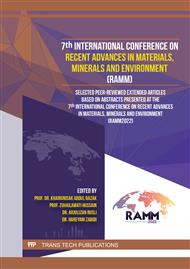[1]
D. Sharma, A. Nagpal, Y. B. Pakade, and J. K. Katnoria, Analytical methods for estimation of organophosphorus pesticide residues in fruits and vegetables: A review, Talanta 82 (2010) 1077–1089.
DOI: 10.1016/j.talanta.2010.06.043
Google Scholar
[2]
H. Dvir, I. Silman, M. Harel, T. L. Rosenberry, and J. L. Sussman, Acetylcholinesterase: From 3D structure to function, Chem. Biol. Interact. 187 (2010) 10–22.
DOI: 10.1016/j.cbi.2010.01.042
Google Scholar
[3]
J.L. Lu, Analysis of Trends of the Types of Pesticide Used, Residues and Related Factors among Farmers in the Largest Vegetable Producing Area in the Philippines., J. Rural Med. JRM / Japanese Assoc. Rural Med. 5 (2010) 184–189.
DOI: 10.2185/jrm.5.184
Google Scholar
[4]
C. Bajet, Pesticide Residues in Food and the Environment in the Philippines: Risk Assessment and Management, FFTC Agric. Policy Artic. (2015).
Google Scholar
[5]
L.S. Kjeldsen, M. Ghisari, and E. C. Bonefeld-Jørgensen, Currently used pesticides and their mixtures affect the function of sex hormone receptors and aromatase enzyme activity, Toxicol. Appl. Pharmacol. 272 (2013) 453–464.
DOI: 10.1016/j.taap.2013.06.028
Google Scholar
[6]
G. Fang, H. Wang, Y. Yang, G. Liu, and S. Wang, Development and application of a quartz crystal microbalance sensor based on molecularly imprinted sol-gel polymer for rapid detection of patulin in foods, Sensors Actuators, B Chem. 237 (2016) 239–246.
DOI: 10.1016/j.snb.2016.06.099
Google Scholar
[7]
S.E. Diltemiz, R. Keçili, A. Ersöz, and R. Say, "Molecular imprinting technology in Quartz Crystal Microbalance (QCM) sensors," Sensors 17 (2017) 454.
DOI: 10.3390/s17030454
Google Scholar
[8]
C. Gomes, G. Sadoyan, R. Dias, and M. Costa, Development of Molecularly Imprinted Polymers to Target Polyphenols Present in Plant Extracts, Processes 5 (2017) 72.
DOI: 10.3390/pr5040072
Google Scholar
[9]
W. Zhang, N. Tan, X. Jia, G. Wang, W. Long, X. Li, S. Liao, and D. Hou, Synthesis, recognition characteristics and properties of l-3-n-butylphthalide molecularly imprinted polymers as sorbent for solid-phase extraction through precipitation polymerization, Mater. Sci. Eng. C 53 (2015) 166–174.
DOI: 10.1016/j.msec.2015.04.034
Google Scholar
[10]
X.F. Zheng, Q. Lian, H. Yang, and X. Wang, Surface molecularly imprinted polymer of chitosan grafted poly(methyl methacrylate) for 5-fluorouracil and controlled release, Sci. Rep. 6 (2016) 21409.
DOI: 10.1038/srep21409
Google Scholar
[11]
Y. Yang, X. Meng, and Z. Xiao, Synthesis of a surface molecular imprinting polymer based on silica and its application in the identification of nitrocellulose, RSC Adv. 8 (2018) 9802-9811.
DOI: 10.1039/c7ra13264f
Google Scholar
[12]
C.J. Percival, S. Stanley, M. Galle, A. Braithwaite, M.I. Newton, G. Mchale and W. Hayes, Molecular-imprinted, polymer-coated quartz crystal microbalances for the detection of terpenes, Anal. Chem. 73 (2001) 4225–4228.
DOI: 10.1021/ac0155198
Google Scholar
[13]
S. Boulanouar, S. Mezzache, A. Combès, and V. Pichon, Molecularly imprinted polymers for the determination of organophosphorus pesticides in complex samples, Talanta 176 (2018) 465-478.
DOI: 10.1016/j.talanta.2017.08.067
Google Scholar
[14]
G.S. Braga, P.A. Lieberzeit, and F.J. Fonseca, Molecularly Imprinted Polymer Based Sensor to Detect Isoborneol in Aqueous Samples, Procedia Eng. 168 (2016) 448–451.
DOI: 10.1016/j.proeng.2016.11.542
Google Scholar
[15]
S. Li, L.M. Qu, J.F. Wang , X.Q. Ran, and X. Niu, Acetylcholinesterase based rGO-TEPA-Copper nanowires biosensor for detecting malathion, Int. J. Electrochem. Sci. 15 (2020) 505-514.
DOI: 10.20964/2020.01.75
Google Scholar
[16]
A.V. Vinotha, D. Tushar, N. Chandrasekaran, and M. Amitava, An ultra-sensitive and selective AChE based colorimetric detection of malathion using silver nanoparticle-graphene oxide (Ag-GO) nanocomposite, Anal. Chim. Acta 1142 (2021) 73-84.
DOI: 10.1016/j.aca.2020.10.057
Google Scholar



